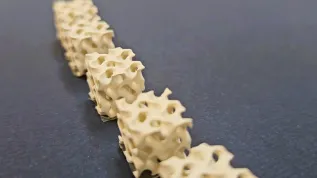
Scientists from the Jagiellonian University have discovered a synthetic polymer characterised by strong antifungal properties and low toxicity. According to the university, the discovery fills a gap among the few available substances used in mycosis treatment and prevention.
The solution was created by an interdisciplinary team led by Dr. Magdalena Skóra from the Department of Infection Control and Mycology at the Faculty of Medicine of the Jagiellonian University Medical College, and Dr. Kamil Kamiński from the Department of Physical Chemistry and Electrochemistry at the Faculty of Chemistry of the Jagiellonian University, the JU Centre of Technology Transfer CITTRU reports in a press release.
The scientists have investigated the properties of various synthetic polymers for their potential use in cosmetics and medicine. They were particularly interested in discovering new substances that could be used in the treatment of mycosis, because, as they explain, their number on the market is limited.
'During our several-year-long studies on polymers, we have created various macromolecules, both synthetic ones and derived from natural polymers. Some of them display the expected antifungal properties, but one synthetic polymer has proved to be an especially promising candidate to be applied in preparations preventing or inhibiting fungal growth,’ says Dr Kamiński.
The researchers say that the discovered polymer displays promising physical and chemical properties from the perspective of cosmetic and pharmaceutical industries. 'It is highly soluble in water and alcohols (methanol and ethanol as well as propanol and isopropanol), which makes it suitable for use in formulations or for superficial application on skin or nails. Besides, it is relatively easy and cheap to synthesise, and the compounds needed to produce it are widely available,’ says the press release.
‘The investigated chemical compound is a cationic polymer (it has a positive charge). This feature enables interaction of a polymer with negatively charged biological membranes of living organisms. This is probably one of the factors contributing to its effectiveness. We think that the polymer interacts with fungal cells, preventing their division or formation of hyphae. During laboratory studies we observed inhibition of fungal growth in the presence of the polymer. At the same time, our cell line research confirmed that the polymer shows low toxicity to mammalian cells. Thus, it has a highly selective activity, specifically targeting fungi,’ says Dr Magdalena Skóra from the Jagiellonian University Medical College.
In vitro studies have confirmed that the investigated polymer has an impact on pathogens causing skin and nail infections: fungi of Trichophyton and Scopulariopsis brevicaulis genera, as well as Fusarium genus, responsible not only for human and animal mycoses, but also plant diseases.
The researchers believe that the polymer they study is less toxic compared to antifungal substances currently used in mycoses treatment: ciclopirox and terbinafine. 'The low toxicity to mammalian cells is not the only advantage of this polymer. We have also discovered that it is more effective in vitro than some other currently used medicinal substances, as its antifungal effect can be observed at several times lower concentrations,’ says Dr. Skóra.
The team continues research on the polymer to better understand its effect on fungi and cells of other living organisms. 'We would like to have as complete data as possible about the effectiveness of the polymer in various concentrations as well as its antimicrobial spectrum and link these information to the observed toxicity levels,’ Skóra adds. Further studies are carried out as part of the project funded by the Polish National Science Centre.
The researchers also want to focus on the commercialisation of the patent-protected invention.
According to Dr. Gabriela Konopka Cupiał, Director of the JU Centre for Technology Transfer CITTRU, the polymer can be used, for example, as an ingredient of antifungal nail and skin care products. 'We are not ruling out collaboration with investors who would like to use the polymer as a medication after further tests are completed. It is also possible to apply the substance in agriculture as a preventive antifungal substance in plant cultivation. As the polymer can be relatively cheaply synthesised, its future use in this sector is also possible,’ Konopka Cupiał says.
The scientists emphasise that possible preparations developed on the basis of the polymer should only be applied superficially and locally. Due to the size of molecules, the substance is not intended for systemic use. (PAP)
PAP - Science in Poland
akp/ bar/ kap/
tr. RL













